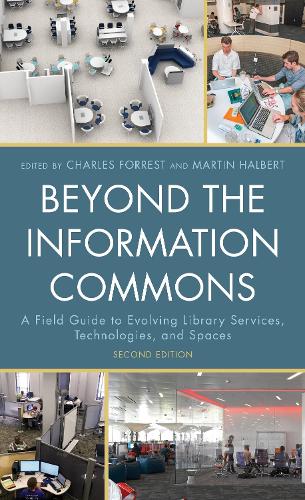
Beyond the Information Commons: A Field Guide to Evolving Library Services, Technologies, and Spaces
(Hardback)
Publishing Details
Beyond the Information Commons: A Field Guide to Evolving Library Services, Technologies, and Spaces
By (Author) Charles Forrest
Edited by Martin Halbert
Bloomsbury Publishing PLC
Rowman & Littlefield Publishers
22nd August 2020
United States
Classifications
Professional and Scholarly
Non Fiction
025.523
Physical Properties
Hardback
232
Width 185mm, Height 264mm, Spine 20mm
662g
Description
In the closing decades of the twentieth century, academic libraries responded to rapid changes in their environment by acquiring and making accessible a host of new information resources, developing innovative new services and collaborative partnerships, and building new kinds of technology-equipped spaces to support changing user behaviors and emerging patterns of learning. The Information Commons or InfoCommons blossomed in a relatively short amount of time in libraries across North America, and around the world, particularly in Europe and the British Commonwealth.
This book is more than a second edition of the 2009 book A Field Guide to the Information Commons which documented the emergence of a range of facilities and service programs that called themselves Information Commons. This new book updates this review of current practice in the Information Commons and other new kinds of facilities inspired by the same needs and intents, but goes beyond that by describing the continued evolution. This new book is an attempt to answer the question: What might be the next emerging concept for a technology-enabled, user-responsive, mission-driven form of the academic library
Like its predecessor, Beyond the Information Commons is structured in two parts. First, a brief series of essays explore the Information Commons from historical, organizational, technological, and architectural perspectives. The second part is a field guide composed of more than two dozen representative entries describing various Information Commons using a consistent format that provides both perspective on issues and useful details about actual implementations. Each of these includes photos and other graphics.
Reviews
Information commons bring together technology, resources, and services in one common physical space to appeal to students. In this update to the 2009 edition of A Field Guide to the Information Commons, editors Forrest and Halbert describe evolutions in information commons over the past 10 years, and discuss how academic libraries are keeping pace with the needs of campus communities. Like the first edition, this book is divided into two distinct parts: essays that explore information commons from historical, organizational, technological, and architectural perspectives; followed by more than two dozen descriptions of information commons in academic libraries worldwide. The books photos and floor plans are helpful for visualizing the space being described. This is a solid work for understanding the past, present, and future of the information commons. Librarians, as well as library science students and professors, will benefit from this worthwhile read. * Library Journal *
Author Bio
Charles Forrest has more than thirty-five years of experience in academic and research libraries. After nearly a decade with the University of Illinois libraries in both Chicago and Urbana-Champaign, he came to Emory University in Atlanta, Georgia, in 1988 where he held a series of administrative positions in the Library, including director of instructional support services, director of planning and budget, and most recently director of library facilities. He served as library project manager for many library construction and renovation projects at Emory, including the Center for Library and Information Resources, a major addition to and renovation of Emorys main library. Charles retired from the University in May 2016. Charles has served as a library juror for the American Institute of Architects/American Library Association Library Building Awards, the American Library Association/International Interior Design Association biennial Library Building Awards, and Library Journals New Landmark Libraries (Academic) series. A published author and regular presenter at conferences, workshops and institutes, he is currently principal and owner of 21st Century Libraries Consulting, LLC.
Dr. Martin Halbert is a recognized figure in library innovation, and serves as Dean of Libraries at the University of North Carolina at Greensboro. He is also President of the Educopia Institute, an educational nonprofit that advances the well-being of libraries by fostering the advancement of shared information systems and infrastructures, and was one of the founding partners of the US National Digital Preservation Program. Halbert has a Ph.D. in interdisciplinary liberal arts from Emory University; his research examines the future of digital scholarship and research library services. He has served as principal investigator for grants and contracts totaling more than $7 M, funding more than a dozen large scale collaborative projects among many educational institutions. Halbert has previously worked for the University of North Texas, Emory University, Rice University, UT Austin, and the IBM Corporation.
